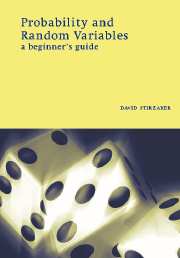Book contents
2 - The rules of probability
Published online by Cambridge University Press: 05 June 2012
Summary
Probability serves to define our hopes and fears.
P. LaplacePREVIEW
In the preceding chapter we suggested that a model is needed for probability, and that this model would take the form of a set of rules. In this chapter we formulate these rules. When doing this, we shall be guided by the various intuitive ideas of probability as a relative of proportion that we discussed in Chapter 1. We begin by introducing the essential vocabulary and notation, including the idea of an event. After some elementary calculations, we introduce the addition rule, which is fundamental to the whole theory of probability, and explore some of its consequences.
Most importantly we also introduce and discuss the key concepts of conditional probability and independence. These are exceptionally useful and powerful ideas and work together to unlock many of the routes to solving problems in probability. By the end of this chapter you will be able to tackle a remarkably large proportion of the better-known problems of chance.
Prerequisites. We shall use the routine methods of elementary algebra, together with the basic concepts of sets and functions. If you have any doubts about these, refresh your memory by a glance at appendix II of chapter 1.
NOTATION AND EXPERIMENTS
From everyday experience, you are familiar with many ideas and concepts of probability; this knowledge is gained by observation of lotteries, board games, sport, the weather, futures markets, stock exchanges, and so on. You have various ways of discussing these random phenomena, depending on your personal experience.
- Type
- Chapter
- Information
- Probability and Random VariablesA Beginner's Guide, pp. 31 - 92Publisher: Cambridge University PressPrint publication year: 1999



